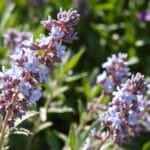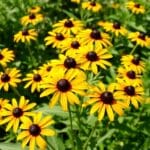Did you know the SFA Gardens have over 350 types of Japanese maples? They cover 16 acres of part-shade garden. This shows how versatile and diverse Acer palmatum is, loved by gardeners everywhere.
I’ve always been drawn to Japanese maples. These trees, from East Asia, are key in garden design. They mix elegance with flexibility, offering beauty all year.
Acer palmatum grows as a shrub or small tree, reaching 10 to 25 feet tall. They come in many shapes and sizes. You can pick from upright, weeping, dwarf, or large trees for your garden.
Japanese maples are very adaptable. They grow well in USDA Hardiness Zones 5 to 8. This makes them perfect for many gardens, from traditional Japanese to modern urban spaces.
Key Takeaways
- Japanese maples offer diverse cultivars for various garden settings
- They thrive in USDA Hardiness Zones 5-8
- Acer palmatum typically grows 10-25 feet tall and wide
- These trees are prized for their stunning autumn foliage
- Japanese maples adapt well to different landscape styles
Introduction to Japanese Maple (Acer palmatum)
I’m always amazed by the beauty of Japanese maples in landscape design. These ornamental trees, native to East Asia, have captured the hearts of gardeners worldwide. With over a thousand different forms, Acer palmatum offers endless possibilities for creating stunning garden scenes.
Origin and Botanical Characteristics
Japanese maples are deciduous trees that can reach heights of 6 to 10 meters, rarely up to 16 meters. Their palmate leaves, typically 4-12 cm long and wide, feature five to nine pointed lobes. The species displays remarkable genetic variation, with leaf size, shape, and color differing even among seedlings from the same parent tree.
Popularity in Garden Design
Japanese maples have gained immense popularity in landscape design due to their striking foliage and compact size. They’re hardy from zones 5 to 8, with some varieties thriving in zones 4 and 9. These versatile trees can be grown in full sun in cooler areas, enhancing their fall colors and crown density. Their adaptability makes them perfect for various garden styles, from traditional Japanese gardens to modern landscapes.
Overview of Diverse Cultivars
The world of Japanese maple cultivars is vast and varied. Thousands of named cultivars exist, each with unique characteristics. From upright forms to weeping varieties, and leaf colors spanning from green to red and purple, there’s a Japanese maple for every garden vision. Some popular red-foliaged cultivars include ‘Atropurpureum,’ ‘Bloodgood,’ and ‘Beni-tsukasa.’ For those interested in japanese maple care, it’s worth noting that these trees respond well to pruning and shaping, allowing for creative landscape design options.
| Cultivar Type | Characteristics | Popular Examples |
|---|---|---|
| Upright | Tall, tree-like form | ‘Bloodgood’, ‘Osakazuki’ |
| Weeping | Cascading branches | ‘Crimson Queen’, ‘Inaba Shidare’ |
| Dwarf | Compact, slow-growing | ‘Shaina’, ‘Mikawa Yatsubusa’ |
The Allure of Japanese Maples in Landscape Design
I love how Japanese maples make landscape design stunning. These trees, from the Aceraceae family, are known for their beauty. They come in 130 species, each with its own charm.
In my experience, Japanese maples are eye-catching in gardens. Their unique shapes and colors add depth and character. From the Bloodgood to the Crimson Queen, each variety has its own beauty.
The autumn foliage of Japanese maples is amazing. As seasons change, their leaves turn into a stunning display of colors. This natural beauty makes any garden more appealing.
| Japanese Maple Variety | Characteristics | Best Use in Landscape |
|---|---|---|
| Bloodgood | Deep red leaves, upright form | Specimen tree, focal point |
| Crimson Queen | Lacy red leaves, weeping habit | Accent near water features |
| Inaba Shidare | Purple-red foliage, cascading form | Container gardening, small spaces |
Adding Japanese maples to landscape design boosts both beauty and mental health. They help us relax yet stay alert. This makes them ideal for peaceful garden spots.
Varieties and Cultivars of Japanese Maples
Japanese maple varieties are stunning for garden lovers. They come in many forms, each with special traits that can make any garden better.
Upright Varieties
Upright Japanese maples are great for garden highlights. The Bloodgood palmatum Japanese maple grows 15 to 20 feet tall. It’s a clear winner for garden focal points.
The Coral Bark palmatum is another favorite. It grows up to 20 feet tall but only spreads 10 to 15 feet wide.
Weeping Varieties
Weeping Japanese maples, or dissectum varieties, bring a soft, flowing look to gardens. The Crimson Queen dissectum Japanese maple grows 8 to 10 feet tall and spreads 10 to 15 feet wide. It’s a top pick for many.
For smaller spots, the Red Dragon dissectum is perfect. It reaches 6 to 8 feet tall and wide, fitting snugly into tight spaces.
Dwarf Cultivars
Dwarf cultivars are great for tiny gardens or pots. They usually grow 6 to 8 feet tall and 8 to 12 feet wide. The Tamukeyama dissectum is a great example, growing only 4 to 6 feet tall but spreading 10 to 15 feet wide.
| Variety | Type | Height (feet) | Width (feet) |
|---|---|---|---|
| Bloodgood | Upright | 15-20 | 15-20 |
| Crimson Queen | Weeping | 8-10 | 10-15 |
| Tamukeyama | Dwarf | 4-6 | 10-15 |
Today, there are over a thousand Japanese maple varieties. Whether you want an upright, weeping, or dwarf maple, there’s one for every garden. These trees are perfect for making any landscape beautiful.
Japanese Maple Leaf Shapes and Colors
Japanese maples are famous for their beautiful japanese maple leaf shapes and bright colors. These deciduous shrubs change with the seasons, making gardens in the United States a sight to behold.
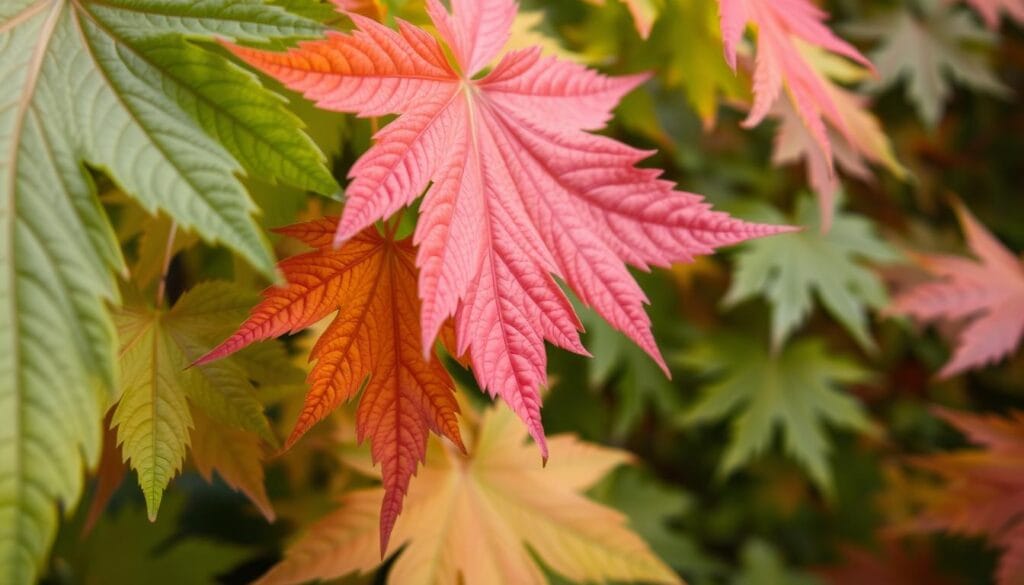
The leaves of Japanese maples are usually 2 to 4 inches long. They come in two types: palm-shaped for Acer palmatum, and lacy for Acer palmatum var. dissectum. This variety lets gardeners pick the perfect fit for their garden.
The autumn foliage of Japanese maples is truly stunning. They turn colors in the fall, showing off vibrant reds, oranges, and yellows. This display is as impressive as the Joshua trees of the American Southwest.
| Leaf Shape | Color Variations | Seasonal Changes |
|---|---|---|
| Palm-shaped | Red, Green, Purple | Spring: Light Green Fall: Bright Red |
| Lacy (Dissectum) | Orange, White, Pink | Spring: Pink/Red Fall: Gold/Orange |
Japanese maples are versatile, growing from 2 to 30 feet tall. They fit into many garden settings, from small containers to large focal points. Their different shapes and sizes make them perfect for creative garden designs.
Growing Conditions for Japanese Maples
Japanese maples love shade and specific conditions to grow well. Knowing what they need is crucial for their care. Let’s look at the best place for these trees to flourish.
Soil Requirements
They prefer acidic, rich, and well-drained soil. They can handle different soils but not alkaline ones. Adding compost helps keep the soil moist and full of nutrients.
Light Preferences
Japanese maples do best in sun to partial shade. In hot areas, they need shade from strong afternoon sun. The right amount of shade brings out their beautiful fall colors.
Water Needs
Young trees need consistent water. I water them twice a week normally, more in dry times. As they grow, they can handle less water. To keep the soil moist, I use a 3-inch bark layer around the roots, but not on the trunk.
| Season | Care Tips |
|---|---|
| Spring | Protect from late frosts, leaf out early |
| Summer | Monitor for pests, especially aphids |
| Fall | Best time for planting, reduce watering for vibrant colors |
| Winter | Low maintenance, remove heavy snow from branches |
With the right conditions, your Japanese maple will be a beautiful garden highlight.
Planting and Care Tips for Japanese Maples
I’ve found that Japanese maples are truly low-maintenance trees, perfect for enhancing landscape design. With over 1,000 varieties available, these versatile trees can fit into any garden style. Let me share some essential japanese maple care tips to help you succeed with these beautiful specimens.
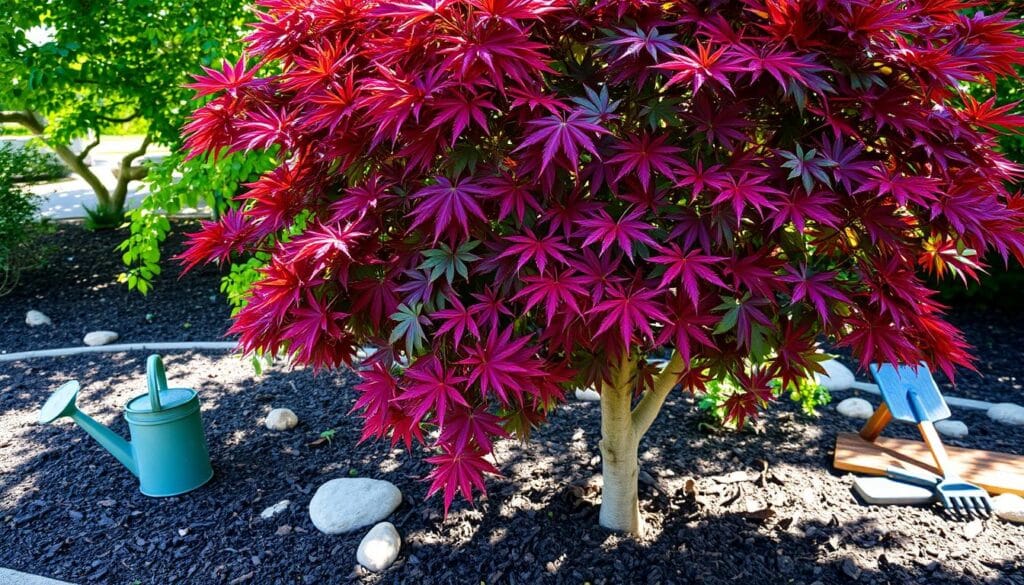
When planting, I choose a spot protected from strong winds. Spring or fall is ideal for planting, ensuring the root ball sits level with or slightly above the soil surface. Mulching around the base helps retain moisture and suppress weeds, making japanese maple care easier.
Watering is crucial, especially for newly planted trees. I water every 1-3 days initially, gradually reducing to once per week during the first growing season. Established trees are fairly drought-tolerant but may need extra water during heat waves or after fertilizing.
Japanese maples are heavy feeders, particularly when young. I apply a balanced slow-release fertilizer once in spring to support healthy growth. This approach keeps them thriving without excessive maintenance.
- Choose a sheltered location
- Plant in spring or fall
- Mulch around the base
- Water regularly, especially when young
- Fertilize sparingly in spring
By following these simple guidelines, you’ll find that japanese maples are surprisingly low-maintenance trees that add elegance to any landscape design.
| Care Aspect | Newly Planted | Established Trees |
|---|---|---|
| Watering Frequency | Every 1-3 days | Once per week or as needed |
| Fertilizing | Once in spring (balanced, slow-release) | Once in spring (balanced, slow-release) |
| Pruning | Minimal, remove dead or damaged branches | Late winter for structure, late spring for aesthetics |
Japanese Maples in Container Gardening
I love growing Japanese maples in containers. These trees, especially the dwarf types, do well in pots. They add elegance to any space. Let’s look at how to grow them successfully in containers.
Choosing the Right Container
Choosing the right container is key. Pick a pot that’s 2 inches wider than the tree’s root ball. For bigger trees, a 20-gallon container is best. Stone, ceramic, or terracotta pots are great because they’re heavy and won’t tip over.
Soil Mix for Potted Japanese Maples
Japanese maples like acidic, well-draining soil with lots of organic matter. I mix one-half EB Stone Azalea Mix with one-half Edna’s Best Potting Soil. This mix drains well but keeps moisture in.
Watering and Fertilizing Container-Grown Maples
Maples in containers need more water than those in the ground. I water them once a week, more often in summer. For fertilizing, I use organic food in mid-March and around July 4th. EB Stone’s Rhody, Azalea, and Camellia food is perfect for these plants.
| Care Aspect | Frequency | Notes |
|---|---|---|
| Watering | 1-2 times per week | Deep watering, avoid leaves |
| Fertilizing | Twice yearly | Mid-March and early July |
| Pruning | As needed | Avoid rainy season |
With the right care, Japanese maples in containers can live for years. They get more beautiful with each season. Remember to mulch with chunky bark and use mineral additives for better leaf color. Happy container gardening!
Pruning and Shaping Japanese Maples
I adore the delicate beauty of Japanese maples in gardens. Pruning them is a gentle art that brings out their natural grace. When it comes to pruning, I’ve found that less is often more.
Winter is the best time for structural pruning. I remove dead, diseased, or crossing branches. This keeps the tree healthy and looking natural. In summer, I do light pruning for a touch-up.
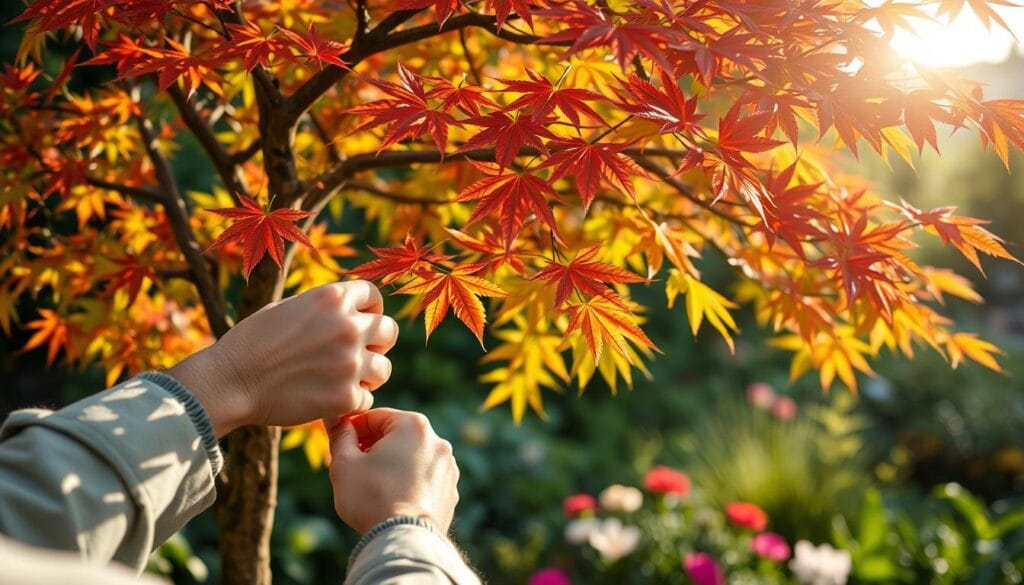
Different pruning tools are used for different tasks in caring for Japanese maples:
- Pruning shears: For branches up to ¾” thick
- Loppers: Handle branches up to 2½” thick
- Pruning saws: Cut branches up to 5″ thick
- Pole pruners: Reach high branches safely
I’m careful not to over-prune young trees. For the first 10-15 years, I let them grow naturally. This patience leads to stronger, more beautiful trees that stand out in gardens.
| Pruning Season | Benefits | Cautions |
|---|---|---|
| Winter | Best for structural changes | Avoid severe cold days |
| Summer | Good for thinning | Protect from sun damage |
| Spring/Fall | Emergency pruning only | Risk of bud damage or frost |
Remember, these ornamental trees do best with gentle care. By learning pruning techniques, I’ve improved my garden design skills. Now, my Japanese maple displays are stunning.
Japanese Maples as Bonsai Specimens
I’ve always been fascinated by bonsai art, and Japanese maples are perfect for it. Their small leaves and beautiful branches make them ideal for bonsai. Dwarf cultivars are especially good because they are compact and easy to shape.
For Japanese maple bonsai care, regular attention is crucial. Pruning, wiring, and repotting are key to keeping the tree healthy and beautiful. It’s a balance between caring for the tree and shaping it over time.
Some Japanese maple cultivars are favorites among bonsai fans. Here’s a quick look at some popular ones:
| Cultivar | Key Characteristics | Care Level |
|---|---|---|
| Deshojo | Striking red leaves | Easy |
| Kiyohime | Dwarf with small leaves | Moderate |
| Arakawa | Rugged bark texture | Challenging |
| Shishigashira | Dense growth habit | Moderate |
Creating a Japanese maple bonsai is rewarding but takes patience. It can take 10 to 20 years to grow a bonsai tree 2-4 feet tall. Beginners should start with seedlings, especially small-leaf varieties, as they grow faster and show adult traits sooner.
Seasonal Beauty: Japanese Maples Throughout the Year
Japanese maples are stunning trees that add beauty to gardens all year. They change with the seasons, making gardens lively and interesting.
Spring Emergence
In spring, Japanese maples come alive with new leaves. These leaves start in colors like soft pinks, bright reds, and greens. It’s the start of their yearly show.
Summer Foliage
Summer is when Japanese maples are at their best. Their leaves form a lush canopy, providing shade and beauty. Some, like ‘Korean Gem’, have light green leaves that pop in summer.
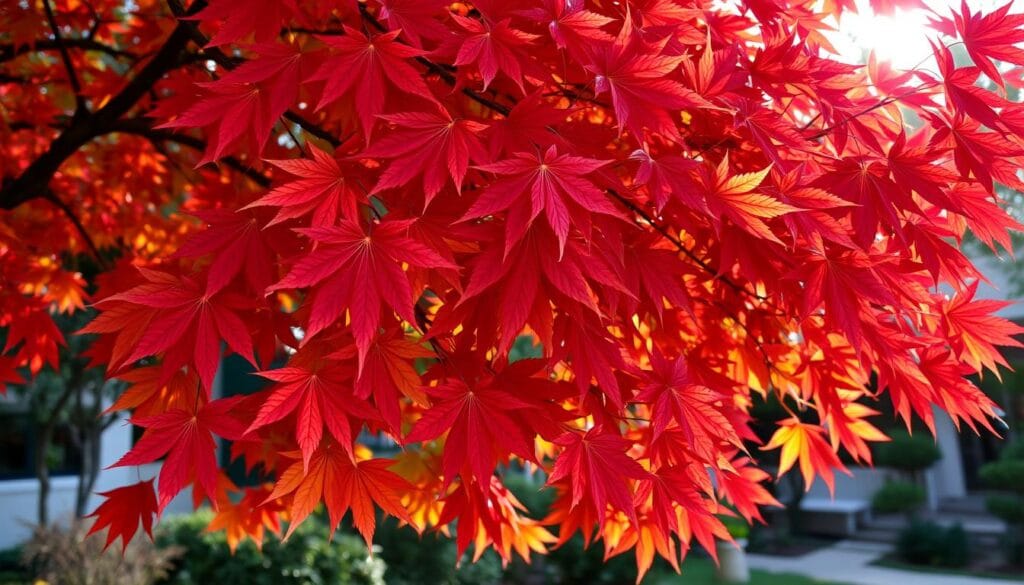
Fall Color Spectacle
Autumn is when Japanese maples really show off. Their leaves turn into stunning reds, oranges, and golds. This makes them a highlight in any garden.
Winter Silhouettes
Even in winter, Japanese maples are beautiful. Their branches create striking silhouettes against the sky. Some, like ‘Korean Gem’, have dark red or almost black bark, adding to the winter scene.
| Season | Characteristic | Visual Appeal |
|---|---|---|
| Spring | New leaf emergence | Vibrant colors (pink, red, green) |
| Summer | Mature foliage | Lush canopy, shade |
| Fall | Autumn foliage | Spectacular reds, oranges, golds |
| Winter | Bare branches | Elegant silhouettes, bark color |
Common Pests and Diseases of Japanese Maples
Japanese maples are known for being easy to care for. But, they still face challenges. Keeping them healthy and beautiful requires the right care. Let’s look at some common problems and how to fix them.
Pests are a big problem for Japanese maples. Japanese beetles can do a lot of damage in a short time. Scale, mealybugs, and mites often attack young trees. Aphids can cause leaves to distort and wilt.
Borers are another issue. They can be identified by sawdust clumps. They tunnel through the trunk and branches.
Diseases also harm these trees. Fungal infections like canker and Verticillium wilt are common. Canker causes sap to ooze from bark damage. Verticillium wilt turns leaves yellow and causes them to fall early.
Anthracnose is another disease. It causes sunken bruises on leaves. It’s especially harmful to young trees.
Prevention and Treatment
To keep Japanese maples healthy, follow these steps:
- Regular pruning to improve air circulation
- Cleaning fallen leaves and twigs
- Yearly mulch replacement
- Appropriate pesticide treatments when necessary
- Avoiding overwatering to prevent root rot
- Using balanced, slow-release fertilizers
Getting an annual check-up from an arborist can help catch problems early. With the right care, Japanese maples can be beautiful additions to your garden.
Companion Plants for Japanese Maples
I enjoy making beautiful landscapes with Japanese maples at the heart. These trees look great with plants that love shade, making Japanese gardens even more stunning. In the Bay Area, where Japanese maples do well, I’ve found some great friends for them.
For plants that grow in the shade, I suggest hostas, ferns, and heucheras. Hostas can grow up to 2 feet tall and 3 feet wide. They have big, colorful leaves that soak up sunlight in shady spots. Ferns, like Dryopteris erythrosora ‘Brilliance’, grow about 2 feet tall and wide. They add fronds that make the landscape look softer.
To add some contrast, I use Hakone grass. It’s good in the shade and easy to care for. Coral bells (Heuchera spp.) add color too. They grow 1 to 1.5 feet tall and have vibrant leaves that look great with Japanese maples.
In bigger areas, I add flowering dogwood (Cornus florida). This native tree grows 15 to 30 feet tall and wide. It blooms with white, pink, or red flowers in early spring. It’s a beautiful backdrop for Japanese maples and adds depth to the garden.
Good companion planting is more than just looks. It’s about making a healthy ecosystem that helps the soil and attracts good bugs. By picking plants that like the same soil and light, you’ll have a garden that’s easy to care for. It will also show off your Japanese maple’s beauty all year.
Japanese Maples in Different Garden Styles
Japanese maples are versatile trees that can make any garden better. They look great in many garden styles, adding beauty to each one. Let’s see how these trees can fit into different garden types.
Japanese Gardens
In traditional Japanese gardens, these trees are key. They’re often near water or as a main attraction. Their beauty and colors match the calm feel of these gardens. The Portland Japanese Garden is a great place to see them.
Modern Landscapes
Japanese maples bring excitement to modern gardens. Their shapes and colors stand out on their own. ‘Bloodgood’ is a favorite for modern designs, growing up to 20 feet tall.
Woodland Gardens
In woodland gardens, Japanese maples add a layer of beauty. They grow well in shade, adding depth. Dwarf varieties, up to 10 feet tall, work well here.
| Garden Style | Recommended Japanese Maple Variety | Height | Key Feature |
|---|---|---|---|
| Japanese Garden | Acer palmatum ‘Deshōjō’ | 15 feet | Bright pink spring foliage |
| Modern Landscape | Acer palmatum ‘Bloodgood’ | 20 feet | Deep purple leaves |
| Woodland Garden | Acer palmatum ‘Crimson Queen’ | Under 10 feet | Lacy, deeply-lobed foliage |
Japanese maples are amazing in many garden styles. They’re perfect for traditional Japanese gardens, modern landscapes, or woodland gardens. These trees can make your outdoor space beautiful.
Famous Japanese Maples in Public Gardens
I love visiting public gardens to see amazing japanese gardens and ornamental trees. The Portland Japanese Garden in Oregon is one of my favorites. It has several stunning Japanese maples that show the beauty of landscape design.
The garden’s star is a famous laceleaf Japanese maple from 1968. Known as the “Tree of Life,” it attracts photographers and visitors worldwide. Its fall colors in late October are unforgettable.
Japanese maples are versatile ornamental trees, with over a thousand varieties. They grow about one foot per year for the first 50 years and can live over a century. This makes them great for public gardens.
| Cultivar | Notable Feature | Best Season |
|---|---|---|
| Sango Kaku | Coral bark | Winter |
| Moonfire | Consistent red leaves | All seasons |
| Tamukeyama | Rich maroon color | Fall |
| Shindeshojo | Flaming red leaves | Spring |
These trees make japanese gardens even more beautiful and inspire landscape design fans. Their compact roots are perfect for borders and paths, adding elegance to public spaces.
Propagation Methods for Japanese Maples
I adore Japanese maples for their beauty and garden versatility. These trees, including dwarf varieties, can be grown in different ways. Knowing how to propagate them is key for gardeners and fans.
Grafting is a common method used by nurseries to create specific Japanese maple types. It joins different maple varieties on one rootstock. This creates trees with unique colors, shapes, and sizes.
Home gardeners can use cuttings to grow new Japanese maples. Taking softwood cuttings in early summer and treating them with rooting hormone works well. After a year, these cuttings can be moved to the ground. This is great for growing more of your favorite dwarf cultivars.
Seed propagation is also an option, though it might not give you exact replicas. Japanese maples do best in zones 5 through 8. They can grow in sun or dappled shade, fitting many garden styles.
FAQ
What makes Japanese Maples so popular in garden design?
What are some popular upright and weeping varieties of Japanese Maples?
What soil conditions do Japanese Maples prefer?
Can Japanese Maples be grown in containers?
How should Japanese Maples be pruned?
Are Japanese Maples suitable for bonsai?
What pests and diseases should I watch for in Japanese Maples?
What companion plants pair well with Japanese Maples?
Are there any famous Japanese Maples in public gardens?
How can Japanese Maples be propagated?
Source Links
- Acer palmatum Firefly Japanese Maple Planted – June 2023
- Acer palmatum – The Aristocrat of Small Trees
- Acer palmatum ‘Green’ ~ Japanese Maple
- The Complete Japanese Maple Guide
- How to Plant and Care for Japanese Maples
- Acer palmatum
- TArt in Nature: The Beauty of Japanese Maples
- 10 Benefits of Having a Japanese Maple
- Shop All Japanese Maples – Upright – Maple Ridge Nursery
- Types of Japanese Maples | PlantingTree – PlantingTree
- The Complete Japanese Maple Guide
- ENH-182/ST023: Acer palmatum: Japanese Maple
- How to Select the Right Japanese Maple for Your Garden
- How to grow Japanese maples / RHS Gardening
- How to Plant and Care for Japanese Maples
- Japanese Maple Care Guide: How To Plant, Grow, And Care For Them
- How to Plant and Care for Japanese Maples
- Growing Japanese Maple Trees In Containers
- Container Japanese Maples: Tips & Tricks from a Pro – Sky Nursery
- Growing Japanese Maples in Pots – PlantingTree
- How to Prune Japanese Maples – PlantingTree
- Learn to Prune Japanese Maples
- 8 Best Japanese Maples For Bonsai
- Care guide for the Japanese maple Bonsai (Acer palmatum) – Bonsai Empire
- Japanese Maples for Bonsai
- How to Select the Right Japanese Maple for Your Garden
- Japanese Maples and Winters: Embracing the Seasonal Beauty
- Japanese Maple Problems – Pests And Diseases For Japanese Maple Trees
- Japanese Maple Problems, Pests and Diseases – North American Tree Service – North American Tree Service
- Japanese Maple Companions Plants | SummerWinds CA Blog
- 13 of the Best Companion Plants for Japanese Maple Trees
- 4 Ideal Companions for Your Japanese Maple
- 20 Japanese Maples You’ll Definitely Want to Plant in Your Yard
- How to Select the Right Japanese Maple for Your Garden
- A Guide to Different Japanese Maple Types | Gardener’s Path
- My Colorful Japanese Maple Grove – The Martha Stewart Blog
- Pacific Horticulture | Choice Japanese Maples
- Everything You Need to Know About Growing a Japanese Maple Tree
- Culture and Propagation of Japanese Maple

